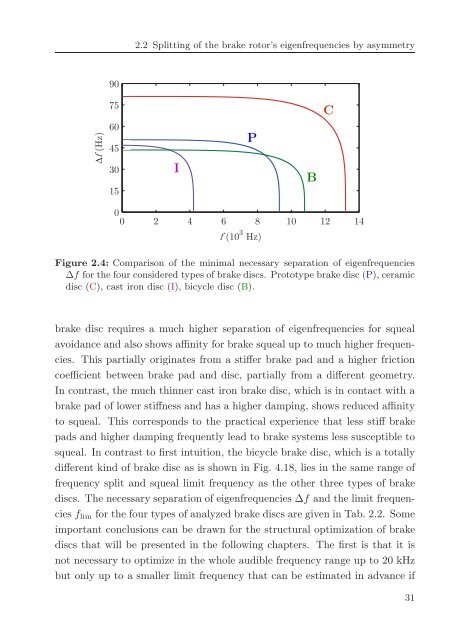Avoidance of brake squeal by a separation of the brake ... - tuprints
Avoidance of brake squeal by a separation of the brake ... - tuprints
Avoidance of brake squeal by a separation of the brake ... - tuprints
Create successful ePaper yourself
Turn your PDF publications into a flip-book with our unique Google optimized e-Paper software.
2.2 Splitting <strong>of</strong> <strong>the</strong> <strong>brake</strong> rotor’s eigenfrequencies <strong>by</strong> asymmetry<br />
<br />
<br />
<br />
<br />
<br />
<br />
<br />
I<br />
P<br />
B<br />
C<br />
<br />
<br />
<br />
Figure 2.4: Comparison <strong>of</strong> <strong>the</strong> minimal necessary <strong>separation</strong> <strong>of</strong> eigenfrequencies<br />
∆f for <strong>the</strong> four considered types <strong>of</strong> <strong>brake</strong> discs. Prototype <strong>brake</strong> disc (P), ceramic<br />
disc (C), cast iron disc (I), bicycle disc (B).<br />
<strong>brake</strong> disc requires a much higher <strong>separation</strong> <strong>of</strong> eigenfrequencies for <strong>squeal</strong><br />
avoidance and also shows affinity for <strong>brake</strong> <strong>squeal</strong> up to much higher frequencies.<br />
This partially originates from a stiffer <strong>brake</strong> pad and a higher friction<br />
coefficient between <strong>brake</strong> pad and disc, partially from a different geometry.<br />
In contrast, <strong>the</strong> much thinner cast iron <strong>brake</strong> disc, which is in contact with a<br />
<strong>brake</strong> pad <strong>of</strong> lower stiffness and has a higher damping, shows reduced affinity<br />
to <strong>squeal</strong>. This corresponds to <strong>the</strong> practical experience that less stiff <strong>brake</strong><br />
pads and higher damping frequently lead to <strong>brake</strong> systems less susceptible to<br />
<strong>squeal</strong>. In contrast to first intuition, <strong>the</strong> bicycle <strong>brake</strong> disc, which is a totally<br />
different kind <strong>of</strong> <strong>brake</strong> disc as is shown in Fig. 4.18, lies in <strong>the</strong> same range <strong>of</strong><br />
frequency split and <strong>squeal</strong> limit frequency as <strong>the</strong> o<strong>the</strong>r three types <strong>of</strong> <strong>brake</strong><br />
discs. The necessary <strong>separation</strong> <strong>of</strong> eigenfrequencies ∆f and <strong>the</strong> limit frequencies<br />
f lim for <strong>the</strong> four types <strong>of</strong> analyzed <strong>brake</strong> discs are given in Tab. 2.2. Some<br />
important conclusions can be drawn for <strong>the</strong> structural optimization <strong>of</strong> <strong>brake</strong><br />
discs that will be presented in <strong>the</strong> following chapters. The first is that it is<br />
not necessary to optimize in <strong>the</strong> whole audible frequency range up to 20 kHz<br />
but only up to a smaller limit frequency that can be estimated in advance if<br />
31

















